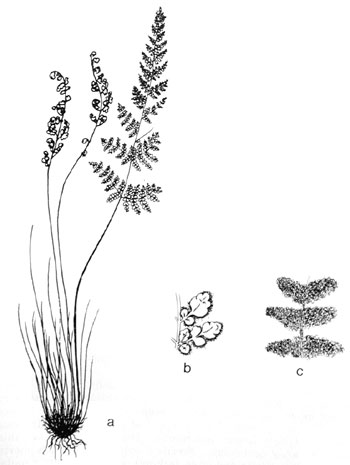|
Hardy Fern Home C. feei resources
All Ferns � Pteridaceae �� Cheilanthes
�Other Genera
|
| Cheilanthes feei | ||
Slender lip fern | ||
|
Etymology
Named after Antoine Fee (1789-1874), a French pteridologist.
Description
Rhizome: short-creeping, scales often uniformly brown but at least some on each plant with well-defined, dark, central stripe, linear.
Frond: 20 cm high by 3 cm wide, deciduous, monomorphic, blade/stipe ratio: 1:1 or less. Stipe: dark brown to black, rounded above, the color extending into the rachis and costae, many arching hairs, vascular bundles: 1. Blade: 2-pinnate-pinnatifid or more divided at the base, lanceolate, papery, gray-green above, white-waxy below, long, segmented, white to tan hairs below, scattered hairs above. Pinnae: 7 to 9 pair, � equilateral; segments utimate segments round to slightly oblong, bead-like, the largest 1--3 mm, margins inrolled; margins serrate; veins free, obscure. Sori: linear, � continuous around segment margins, submarginal, indusium: false, continuous along the margin, sporangia: black, maturity: late spring to fall. Culture
Habitat: cliffs and ledges, usually on limestone or sandstone.
Distribution: Mexico to British Columbia, east to midwestern North America, disjunct further east.
Hardy to -25�C, USDA Zone 5.
Distinctive Characteristics
The�convex segments cause them to be called bead-like, which they are, but not on the scale of C. covillei. The more diagnostic feature is the very long white to tan hairs, some of which exceed the dimensions of the segments. The resource at Missouri Plants has good diagnostic photos.
|
|
|

Cheilanthes feei. a) fronds, b) upper pinnule surface, c) lower surface. �Illustration by V. Fulford from Ferns and Fern Allies of Canada, William J. Cody and Donald M. Britton, 1989, � Agriculture Canada, used with permission. |
